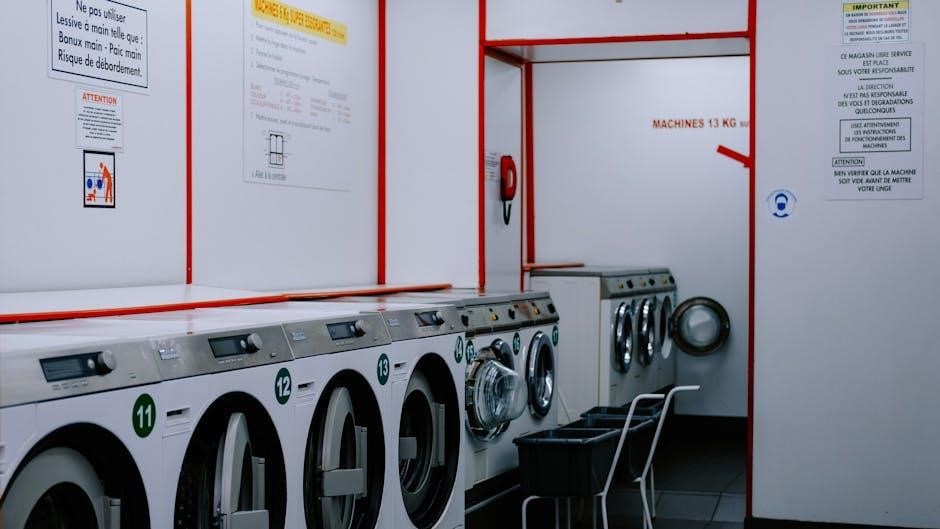The L5P delete instructions guide diesel truck owners through removing emissions components like DPF‚ EGR‚ and SCR to enhance performance‚ fuel efficiency‚ and engine longevity while requiring specific tools and tuning.
1.1 What is the L5P Duramax Engine?
The L5P Duramax engine is a 6.6L turbo-diesel V8 engine used in Chevrolet and GMC trucks from 2017 to 2021. Known for its power and reliability‚ it delivers impressive torque and horsepower‚ making it a favorite among diesel enthusiasts. The L5P is renowned for its strength and durability‚ which is why many owners opt for modifications like delete kits to further enhance its performance and efficiency‚ despite potential legal and warranty considerations.
1.2 Purpose of L5P Delete Modifications
The primary purpose of L5P delete modifications is to remove restrictive emissions systems‚ such as DPF‚ EGR‚ and SCR‚ to unlock the engine’s full potential. These deletions aim to increase power‚ improve fuel efficiency‚ and reduce maintenance costs. By eliminating emissions-related components‚ drivers can enjoy enhanced performance and lower long-term expenses‚ although they must consider legal implications and potential impacts on factory warranties before proceeding with such modifications.

Components of an L5P Delete Kit
An L5P delete kit includes a DPF delete pipe‚ EGR delete kit‚ and SCR delete kit to remove emissions systems and improve engine performance.
2.1 DPF (Diesel Particulate Filter) Delete
The DPF delete involves removing the factory Diesel Particulate Filter and replacing it with a straight exhaust pipe to eliminate filtration and regeneration processes. This modification enhances exhaust flow‚ reducing back pressure and improving engine performance. Additionally‚ it prevents filter clogging and reduces maintenance costs. However‚ it’s crucial to pair this modification with proper tuning to ensure the engine management system recognizes the changes and operates efficiently.

2.2 EGR (Exhaust Gas Recirculation) Delete
The EGR delete removes the Exhaust Gas Recirculation system‚ which can cause issues like clogged coolers and valves. This modification allows the engine to operate at lower temperatures‚ improving efficiency and reducing soot buildup in the intake system. An EGR delete kit is installed to block exhaust gas flow‚ preventing recirculation. Proper tuning is essential to ensure the engine management system adapts to the changes‚ maintaining performance and preventing potential damage. This modification is often paired with other deletes for optimal results.
2.3 SCR (Selective Catalytic Reduction) Delete

The SCR delete involves removing the Selective Catalytic Reduction system‚ which injects DEF (Diesel Exhaust Fluid) to reduce emissions. This modification eliminates DEF consumption‚ saving costs and reducing maintenance. The SCR delete kit typically includes a delete pipe and tuning to disable the SCR system. Proper installation ensures the engine operates without error codes or performance issues. This delete is often performed alongside DPF and EGR deletes to maximize performance and efficiency gains. Professional tuning is crucial to avoid drivability problems.
Tools and Requirements for L5P Delete
Essential tools include an E41 unlock kit or pre-unlocked ECM‚ HP Tuners MPVI3 device‚ tuning credits‚ and a year-specific CAN plug kit for proper installation and tuning.
3.1 ECM Unlocking: E41 Kit or Pre-Unlocked ECM
ECM unlocking is critical for L5P delete modifications. Owners can use an E41 kit to unlock the factory ECM or purchase a pre-unlocked ECM. Unlocking enables custom tuning‚ allowing the engine to function without emissions systems like DPF‚ EGR‚ and SCR. Without proper unlocking‚ the truck may become undriveable due to active emissions-related error codes and regeneration cycles. This step ensures compatibility with delete kits and tunes‚ preventing performance issues and maintaining engine reliability.
3.2 HP Tuners MPVI3 Device
The HP Tuners MPVI3 device is essential for L5P delete modifications‚ enabling owners to load custom tunes onto the unlocked ECM. This tool allows precise calibration of the engine control module‚ ensuring proper operation after emissions system removal. It supports delete tunes‚ eliminating regeneration cycles and fault codes. The MPVI3 interfaces with a Windows computer‚ requiring tuning credits for specific year models. It’s a crucial component for achieving optimal performance and ensuring compatibility with the L5P engine’s updated CAN protocol.
3.3 Tuning Credits and Year-Specific CAN Plug Kit
Tuning credits are required to access and modify the L5P ECM‚ typically purchased alongside the HP Tuners MPVI3 device. A year-specific CAN plug kit ensures compatibility with the truck’s communication network‚ enabling proper data transfer between the tuner and ECM. These components are vital for loading delete tunes and ensuring the engine operates efficiently without emissions systems. They prevent communication errors and ensure the tuning process is smooth and effective for optimal performance post-delete.

Step-by-Step Tuning Process
The process involves unlocking the ECM using an E41 kit or pre-unlocked ECM‚ then installing the delete tune with the HP Tuners MPVI3 device to optimize performance.
4.1 Unlocking the Factory ECM
Unlocking the factory ECM is essential for installing a delete tune. Owners can use an E41 kit to unlock the ECM or purchase a pre-unlocked unit. This step ensures the engine computer can accept custom tuning‚ allowing the removal of emissions-related functions like DPF and EGR. Proper unlocking prevents issues during the tuning process and ensures the truck runs smoothly after modifications. It’s a critical first step in the delete process.
4.2 Installing the Delete Tune

After unlocking the ECM‚ the next step is installing the delete tune using tools like the HP Tuners MPVI3 device. This process involves loading custom software to recalibrate the engine’s performance. A Windows computer and tuning credits are required to ensure compatibility. The delete tune eliminates emissions-related functions and optimizes engine performance. It’s crucial to follow precise instructions and clear any existing codes before flashing the tune. Proper installation ensures improved power‚ efficiency‚ and smooth operation. Always test the truck thoroughly post-installation to confirm everything functions as expected.
Legal and Warranty Considerations
Performing an L5P delete violates emissions regulations‚ making it illegal in most regions. It also voids the manufacturer’s warranty‚ potentially leading to legal consequences and inspection failures.
5.1 Emissions Regulations and Legal Implications
Performing an L5P delete violates EPA emissions regulations‚ as it removes mandatory systems like DPF‚ EGR‚ and SCR. This modification is illegal for on-road vehicles‚ with no legal loopholes. Tampering with emissions systems can result in failed inspections‚ fines‚ and penalties. Owners risk legal consequences‚ including potential lawsuits and loss of vehicle registration. Compliance with emissions standards is strictly enforced‚ making deletes non-compliant and subject to regulatory action.
5.2 Impact on Manufacturer Warranty
Installing an L5P delete kit voids the manufacturer’s warranty‚ as it modifies emissions systems and alters factory settings. Dealerships can detect these changes through diagnostic tools‚ leading to denied repairs and services. Owners may face financial losses for repairs and potential legal action. Warranty termination is irreversible‚ leaving owners without coverage for future issues. This risk is significant‚ especially for newer trucks‚ highlighting the importance of considering long-term consequences before proceeding with such modifications.
Benefits of an L5P Delete
An L5P delete enhances engine performance‚ increases power output‚ and improves fuel efficiency by eliminating restrictive emissions systems‚ allowing for smoother operation and reduced maintenance costs.
6.1 Increased Power and Performance

Removing emissions systems like DPF‚ EGR‚ and SCR through an L5P delete kit allows the engine to breathe more freely‚ unlocking significant increases in power and torque. This modification reduces engine restriction‚ enabling the Duramax L5P to produce maximum horsepower and improve throttle response. The delete kit‚ combined with proper tuning‚ recalibrates engine settings to optimize performance‚ making it ideal for heavy-duty hauling and high-performance driving applications while maintaining reliability.
6.2 Improved Fuel Efficiency
By eliminating emissions systems like the DPF‚ EGR‚ and SCR‚ the L5P delete kit reduces engine restriction‚ allowing for better airflow and combustion efficiency. This leads to improved fuel economy‚ especially during long drives or when towing heavy loads. Proper tuning ensures the engine operates optimally without emissions-related limitations‚ maximizing fuel efficiency. However‚ it’s crucial to note that while fuel savings are possible‚ the legality and potential warranty impacts of these modifications must be considered before proceeding with the delete process.
Risks and Potential Drawbacks
L5P delete modifications can lead to legal issues‚ failed inspections‚ and voided warranties. Engine longevity may suffer without emissions systems‚ potentially causing costly damage over time.
7.1 Engine Longevity Concerns
Removing emissions systems like the DPF‚ EGR‚ and SCR can strain the engine over time. Without these components‚ soot and contaminants may accumulate‚ leading to premature wear on cylinders‚ pistons‚ and turbochargers. Additionally‚ the engine’s cooling system may be taxed‚ potentially causing overheating issues. These factors can result in costly repairs if not properly managed. Regular maintenance becomes even more critical to mitigate long-term damage.
7.2 Inspection and Compliance Issues
Deleting emissions systems can lead to inspection failures and compliance violations. Many states require functional DPF‚ EGR‚ and SCR systems‚ and their removal may result in failed emissions tests. Additionally‚ modern vehicles are equipped with sensors that monitor these systems‚ and deleting them can trigger persistent error codes. This may lead to legal consequences‚ fines‚ or the inability to register the vehicle. Owners must weigh these risks against potential performance gains.
The L5P delete enhances power‚ efficiency‚ and engine longevity but involves legal risks and inspection challenges. Professional installation is crucial for optimal results and minimal issues.
8.1 Final Thoughts on L5P Delete Instructions
Completing an L5P delete requires careful planning‚ proper tools‚ and professional expertise. While the benefits are significant‚ owners must weigh legal risks‚ warranty impacts‚ and potential challenges. Ensuring all components are correctly removed and tuned is vital for optimal performance. Stay informed about emissions regulations and consider consulting professionals to avoid complications. The decision to delete should be made with full awareness of the consequences and benefits involved.
8.2 Importance of Professional Installation

Professional installation of an L5P delete is crucial to ensure proper removal of emissions components and accurate tuning. Incorrect installation can lead to engine damage‚ poor performance‚ or legal issues. Experts have the tools and knowledge to handle complex systems like the ECM‚ DPF‚ and EGR‚ ensuring compliance with modifications and optimizing results. DIY attempts risk voiding warranties‚ failing inspections‚ or causing irreversible harm to the engine. Trusting a professional guarantees safety‚ efficiency‚ and long-term reliability for your vehicle.